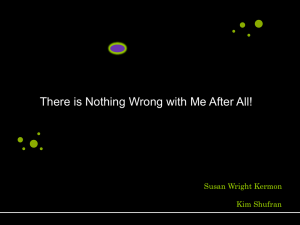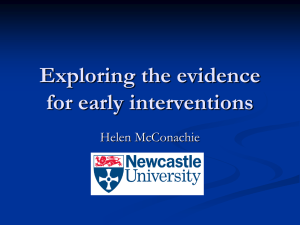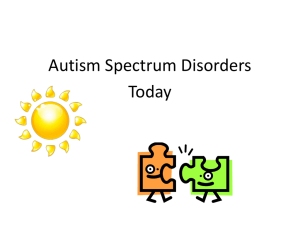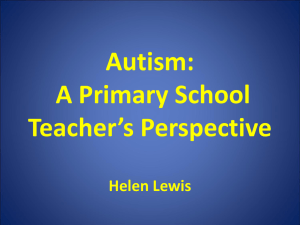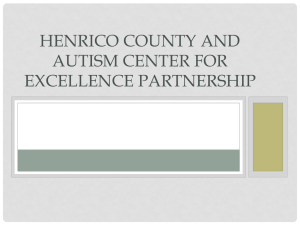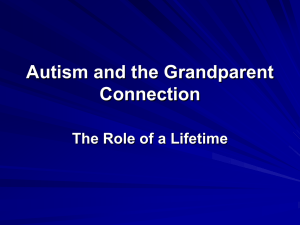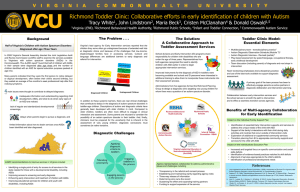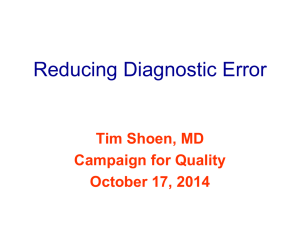Best Practice Guidelines for the Assessment and
advertisement
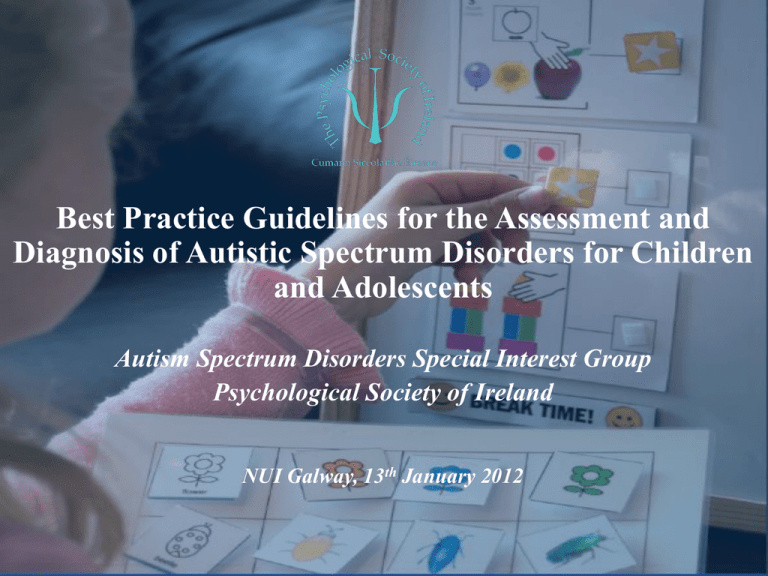
Best Practice Guidelines for the Assessment and Diagnosis of Autistic Spectrum Disorders for Children and Adolescents Autism Spectrum Disorders Special Interest Group Psychological Society of Ireland NUI Galway, 13th January 2012 Overview • Development and purpose of the guidelines • Introduction to the guidelines Components of the assessment Diagnostic process: Psychological evaluation Differential diagnosis Feedback to parents Development of the Guidelines In reply to the stated needs of our special interest group members, and in response to inquiries and questions from other interested professionals Discussions at ASDSIG meetings throughout 2005-2009 It is intended to use these guidelines in conjunction with the International Test Commission Guidelines on the use of Psychometric Tests and the PSI proposed Policy on the use of Psychometric Tests in Ireland Purpose of the Guidelines Intended as a tool to help psychologists make informed decisions regarding their role in identification, diagnosis and assessment Provides recommendations, guidance, and information Based on current international best practice International Literature Assessment, Diagnosis and Clinical Interventions for Children and Young People with Autism Spectrum Disorders, A National Clinical Guideline (Scottish Intercollegiate Guidelines Network, 2007) National Autism Plan for Children (National Autistic Society, 2003) Standards & Guidelines for the Assessment & Diagnosis of Young Children with ASD in British Columbia (British Columbia Ministry of Health Planning, 2003) Children’s Mental Health Ontario (2003) Autistic Spectrum Disorders: Best Practice Guidelines for Screening, Diagnosis and Assessment (California Dept. of Developmental Services, 2002) The Report of the Task Force on Autism (Department of Education and Science, 2001) Introduction to the Guidelines 1 Multi-disciplinary approach is optimum to provide a comprehensive assessment and diagnosis Primary goal is to characterise difficulties that can lead to the most appropriate intervention service for the child and family Difficulties must be interpreted relative to the child’s developmental level Accurate assessment of cognitive functioning is essential for prognosis and intervention planning Introduction to the Guidelines 2 A best estimate of cognitive functioning is fundamental to the diagnostic assessment process and can be reasonably obtained by appropriate test selection and adaptation of procedures Differential diagnosis allows for the identification of clinical features consistent with an ASD, as well as other disorders of childhood Literature suggests that there may be an under-diagnosis of girls Introduction to the Guidelines 3 Early Childhood Primary School Secondary School Guidelines addresses this in highlighting differences in approaches in the age groups 0 – 6 years 6 – 18 years Diagnostic Process Suspicion Screening Referral to local Child and Family Centre or ASD Team - Multidisciplinary Assessment where parents are involved as active participants in the diagnostic process Feedback to parents Treatment and intervention Components of the Assessment & Diagnostic Process Review of records/history Medical/physical evaluation Developmental interview with Parent/Guardian Direct child evaluation Direct observation Interview Psychological evaluation Cognitive assessment Adaptive functioning assessment Mental health assessment Communication assessment Evaluation of social competence & functioning Restrictive behaviours, interests and activities Family functioning Secondary Components Differential Diagnosis Feedback to parents/clients Parent/Guardian Interview Detailed developmental history Description of specific impairments or differences Developmental timing/pattern in triad of impairments Autism Diagnostic Interview – Revised (ADI-R) The Diagnostic Interview for Social and Communication Disorders (DISCO) Direct Child Evaluation Observation of the child home preschool school with peers Identify behaviours and symptoms relating to DSM/ICD criteria Autism Diagnostic Observation Schedule – Generic (ADOS-G) Child Interview Manage conversation, reciprocity, initiation, shifting, maintenance Recognise & respond to clarification or requests Interpret non-literal language i.e. humour, sarcasm, irony Recognise indirect and polite forms Awareness of the need to shift in register Flexibility in dealing with situations & ability to modulate response Nonverbal communication, such as gaze, body positioning, mirroring etc. Psychological Assessment Every effort should be made to get a ‘best estimate’ of child’s cognitive functioning. Why is this important? Provides a framework for the interpretation of all of the other qualitative and quantitative observations (made as part of the observation) Provides a framework for decisions on intervention and teaching strategies Identification of strengths Entitlement to services Formal Testing Individuals with an ASD cover the entire spectrum of intellectual functioning and formal language capacities However A large number present with significant Language delay Social interaction Poor imitation skills High distractibility Low tolerance Issues in Psychometric Testing Correlations between different batteries reported in test manuals may not be directly applicable to this population Drops in standard scores over time Drops in standard scores at around school entry Be cognisant of ‘floor effects’ Be aware of complexity of diagnoses at extreme ends of cognitive ranges Challenge of defining what is the ‘average’ in autism Challenge of assessing nonverbal, uncooperative children Formal Testing: Tests of General Ability Bayley Scales of Infant Development III Griffiths Mental Development Scales Stanford – Binet Intelligence Scale: 5th Edition Wechsler Pre-school and Primary Scale of Intelligence: 3rd UK Edition (WPPSI-III UK) Wechsler Intelligence Scale for Children: 4th UK Edition (WISCIV UK) Kaufman Assessment Battery for Children, 2nd Edition British Ability Scales II Woodcock-Johnson III NU Test of Cognitive Abilities (WJ-III) Non Verbal Measures Leiter International Performance Scale Battery: Revised Wechsler Nonverbal Scale of Ability Test of Nonverbal Intelligence 3rd Edition (TONI III) Raven’s Progressive Matrices Adaptive Functioning The capacity for personal and social self sufficiency in real life situations. Information about child’s typical functioning Key consideration in determing supports for independent living Adaptive behaviour deficits not in keeping with overall cognitive level (Klin et. al., 2007) In ASD populations, inconsistent correlations between adaptive functioning and ASD symtomatology, depending on age and cognitive functioning (Perry, Flanagan, Geiier & Freeman, 2009) Adaptive Functioning Vineland Adaptive Behaviour Scales 2nd Edition Interview Edition (2006) Adaptive Behaviour Assessment System 2nd Edition (ABAS II) AAMD Adaptive Behaviour Scales Adaptive Behaviour Scale: Second Edition Mental Health Assessment Inform differential diagnosis & determine the presence of co-existing conditions Self report measures for children & adolescents: Piers Harris Self-Esteem Scale Becks Youth Inventories Achenbach Child Behaviour Checklist – Youth Self Report Behaviour Assessment System for Children – Self Report of Personality Protocol Communication Assessment Analysis of socio-communicative & socio-affective behaviours: Eye contact & use of gaze to communicate intent and share attention Gestures such as pointing & coordination of gesture and eye gaze Body language – recognition of personal space Turn-taking skills Use of facial expression to communicate Assess across settings & under differing degrees of structure and interactive partners. Measures including nonverbal/preverbal communicative components: Communication and Symbolic Behaviour Scales Autism Diagnostic Observation Schedule-Generic Assessment of Social Competence Data collection from multiple sources: Observation during the evaluative assessment Teachers & other care providers Parent interview Naturalistic setting Measures include: Vineland Adaptive Behaviour Scales (teacher & parent edition) Adaptive Behaviour Assessment System Child Behaviour Checklist Restricted and Repetitive Behaviours Stereotyped behaviours Repetitive use of objects Self-injury Object attachment Repetitive use of language Narrow and circumscribed interests Is there a clear function? Is this developmentally appropriate? Could the same RRB be better described by another condition? Family Functioning Important element of diagnostic evaluation and intervention Family needs for support, respite, and management of challenges within the home Diagnostic process is often highly stressful for the family, particularly if the dx is unclear Secondary Components Academic assessment in the school age child or adolescent Assessment of basic concepts in younger children Learning styles and thinking differences Comorbidities Intellectual disability – 55% (Charman, Pickles, Simonoff, Chandler, Loucas & Baird, 2011) ADHD Anxiety Disorders Epilepsy Genetic disorders: Down Syndrome, Fragile X, Tuberous Sclerosis Depression GI difficulties Differential Diagnosis Important to differentiate ASDs from conditions that lead to abnormalities in language, play and social development Over 60 different metabolic disorders & genetic syndromes associated with ASDs Need for caution superficial similarities between ASD and the behavioural phenotypes of certain genetic syndromes (Moss & Howlin, 2010) Differential Diagnosis Asperger Syndrome ADHD Developmental delay/Intellectual disability Developmental Language Disorders Visual and hearing impairments Neurological dysfunction Genetic syndromes Differential Diagnosis ODD/Conduct Disorder Selective mutism Schizophrenia Depression Anxiety Disorders Psychological deprivation Coexisting conditions Feedback to Parents/Client Clearly and accurately explain the nature of the ASD, and if relevant, intellectual disability Be wary of making long term predictions; be sensitive Clearly state if you don’t know something and allow parents to hold onto hope Offer guidance and support, e.g., parent support groups Initiate ‘treatment’ immediately Give information to take home Provide a follow-up appointment and provide the name of a contact person Access the document.. PSI members: free to download from www.psychologicalsociety.ie Non PSI-members contact The Psychological Society of Ireland, Floor 2, Grantham House, Grantham Street, Dublin 2 Tel : 01- 472 0105 or info@psihq.ie Thanks for listening! Any questions?
